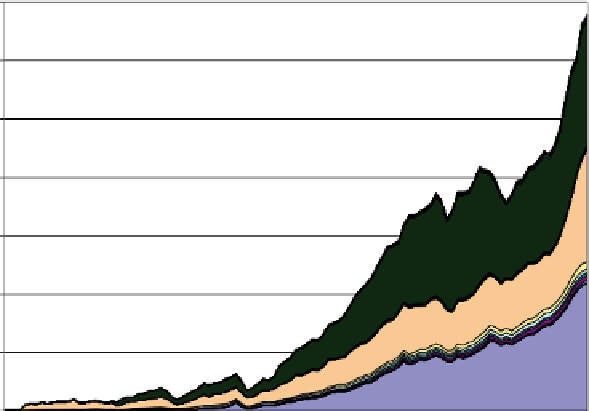Geology Reference
In-Depth Information
Zirconium
Zinc
Wolfram
Vanadium
Uranium
Titanium-rutile
Titanium-ilmenite
Tin
Tantalum
Silver
Silicon
Rhenium
REE
Potash
Phosphate rock
Nickel - sulfides
Nickel - laterites
Molybdenum
Mercury
Manganese
Lithium
Lead
Iron ore
Gypsum
Gold
Fluorspar
Copper
Cobalt
Chromium
Cadmium
Bismuth
Beryllium
Arsenic
Antimony
Aluminium (Bauxite)
3,500,000
3,000,000
2,500,000
2,000,000
1,500,000
Potash
1,000,000
Iron ore
500,000
Aluminium
0
Fig. 13.33 Natural bonus loss associated with the extraction of the main non-fuel mineral com-
modities on Earth throughout the 20th century
gypsum, copper, fluorspar, cobalt and wolfram significantly contribute to the degra-
dation of the planet's non-fuel mineral wealth. The average exergy cost degradation
velocity B
of the 20th century is around 0.9 Gtoe/yr and substantially increases
in the last decade to 2.5 Gtoe/yr.
According to the depletion ratios (% R loss) in Table 13.3, mankind has ex-
hausted in just only a century around 43% of the world's non-fuel mineral reserves,
with the estimated years until depletion of the total reserves around 142 years, as
highlighted in Sec. 11.3.2.
According to Fig. 13.35, the most depleted commodities are, in decreasing order:
mercury, with 89% of the reserves extracted, tin (77%), arsenic (75%), antimony
(74%), gold (74%), lead (73%) and silver (72%). On the other hand, the minerals
of cesium, thorium, REE, iodine, vanadium, potash, PGM, tantalum, aluminium
and cobalt are the least depleted commodities, having less than 20% extracted
from their respective world resources. A mineral's depletion degree depends on
two factors: firstly the abundance of the considered mineral reserve and secondly
their production rates. Usually, the least depleted minerals coincide with those
substances, for which no important usefulness has been found until recently. It can
also be connected to notable physical abundance as is the case for iodine, aluminium
or potash. This situation can of course change dramatically with the development
of emerging technologies such as those identified in Sec. 1.4. The development














Search WWH ::

Custom Search